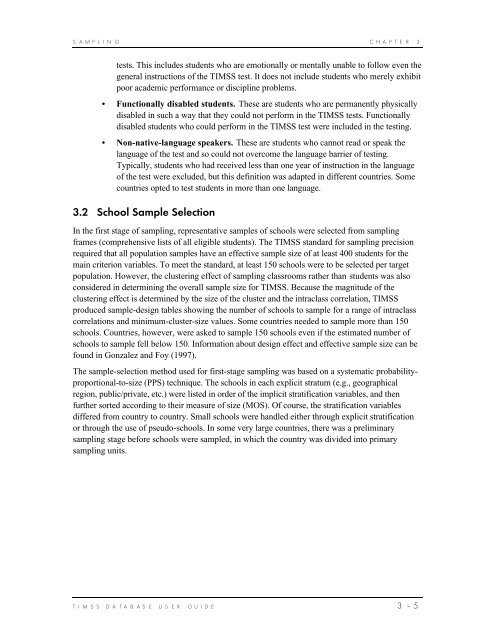User Guide for the TIMSS International Database.pdf - TIMSS and ...
User Guide for the TIMSS International Database.pdf - TIMSS and ...
User Guide for the TIMSS International Database.pdf - TIMSS and ...
Create successful ePaper yourself
Turn your PDF publications into a flip-book with our unique Google optimized e-Paper software.
S A M P L I N G C H A P T E R 3<br />
tests. This includes students who are emotionally or mentally unable to follow even <strong>the</strong><br />
general instructions of <strong>the</strong> <strong>TIMSS</strong> test. It does not include students who merely exhibit<br />
poor academic per<strong>for</strong>mance or discipline problems.<br />
• Functionally disabled students. These are students who are permanently physically<br />
disabled in such a way that <strong>the</strong>y could not per<strong>for</strong>m in <strong>the</strong> <strong>TIMSS</strong> tests. Functionally<br />
disabled students who could per<strong>for</strong>m in <strong>the</strong> <strong>TIMSS</strong> test were included in <strong>the</strong> testing.<br />
• Non-native-language speakers. These are students who cannot read or speak <strong>the</strong><br />
language of <strong>the</strong> test <strong>and</strong> so could not overcome <strong>the</strong> language barrier of testing.<br />
Typically, students who had received less than one year of instruction in <strong>the</strong> language<br />
of <strong>the</strong> test were excluded, but this definition was adapted in different countries. Some<br />
countries opted to test students in more than one language.<br />
3.2 School Sample Selection<br />
In <strong>the</strong> first stage of sampling, representative samples of schools were selected from sampling<br />
frames (comprehensive lists of all eligible students). The <strong>TIMSS</strong> st<strong>and</strong>ard <strong>for</strong> sampling precision<br />
required that all population samples have an effective sample size of at least 400 students <strong>for</strong> <strong>the</strong><br />
main criterion variables. To meet <strong>the</strong> st<strong>and</strong>ard, at least 150 schools were to be selected per target<br />
population. However, <strong>the</strong> clustering effect of sampling classrooms ra<strong>the</strong>r than students was also<br />
considered in determining <strong>the</strong> overall sample size <strong>for</strong> <strong>TIMSS</strong>. Because <strong>the</strong> magnitude of <strong>the</strong><br />
clustering effect is determined by <strong>the</strong> size of <strong>the</strong> cluster <strong>and</strong> <strong>the</strong> intraclass correlation, <strong>TIMSS</strong><br />
produced sample-design tables showing <strong>the</strong> number of schools to sample <strong>for</strong> a range of intraclass<br />
correlations <strong>and</strong> minimum-cluster-size values. Some countries needed to sample more than 150<br />
schools. Countries, however, were asked to sample 150 schools even if <strong>the</strong> estimated number of<br />
schools to sample fell below 150. In<strong>for</strong>mation about design effect <strong>and</strong> effective sample size can be<br />
found in Gonzalez <strong>and</strong> Foy (1997).<br />
The sample-selection method used <strong>for</strong> first-stage sampling was based on a systematic probabilityproportional-to-size<br />
(PPS) technique. The schools in each explicit stratum (e.g., geographical<br />
region, public/private, etc.) were listed in order of <strong>the</strong> implicit stratification variables, <strong>and</strong> <strong>the</strong>n<br />
fur<strong>the</strong>r sorted according to <strong>the</strong>ir measure of size (MOS). Of course, <strong>the</strong> stratification variables<br />
differed from country to country. Small schools were h<strong>and</strong>led ei<strong>the</strong>r through explicit stratification<br />
or through <strong>the</strong> use of pseudo-schools. In some very large countries, <strong>the</strong>re was a preliminary<br />
sampling stage be<strong>for</strong>e schools were sampled, in which <strong>the</strong> country was divided into primary<br />
sampling units.<br />
T I M S S D A T A B A S E U S E R G U I D E 3 – 5

















